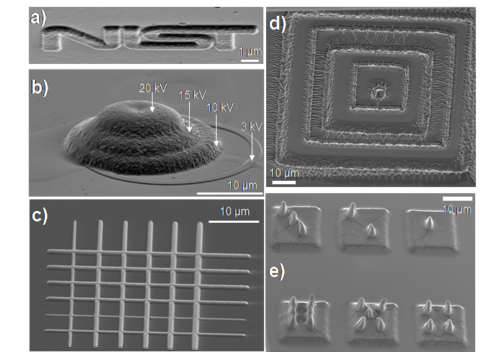Electron or X-Ray Beam Lithography in Liquids

Description
These days, the fabrication of 2D and 3D structures out of liquid, biocompatible, hydrogel solutions has become pivotal technology for tissue engineering, soft robotics, biosensing, drug delivery, wound treatment and biomedical research. With this invention, the electron or x-ray beam penetrates into the liquid after passing through an electron (x-ray transparent) ultrathin membrane and crosslinks the polymer molecules in the liquid solution within the interaction volume (The volume inside the specimen in which interactions occur while being struck with the electron or x-ray beam). Crosslinking involves a chemical reaction between polymer chains to link them together, much like a plate of spaghetti wherein there are individual strands that can be pulled off the plate. With the occurrence of crosslinking, a chemical reaction takes place that bonds the “spaghetti” together and no longer allows for pulling out an individual strand.
Nowadays, state of the art, photo-induced 3D printing exhibits resolution in the order of a micron. This technology, however, can achieve much higher resolution. This is done through the printing of structures directly from a liquid state, which enables gel encapsulation of the objects. This technique also shows potential in encapsulating live cells for tissue engineering, and offers flexibility in resolution, size, and shape of structures that can be fabricated via tuning of multiple parameters like beam energy, current, and dwell time. Widespread use of this technique could be possible as commercially available equipment can be used (scanning electron microscope (SEM) and x-ray microscopes). A diverse range of materials can be printed via this technique, including compositional gel materials, which are not optically transparent, and cannot be printed using UV printing.
A prototype setup is represented in the Figure 1 below. A silicon (Si) chip with nine silicon nitrogen (SiN) 50 nm thin membranes sealed the volume filled with Polyethylene Glycol Diacrylate (PEGDA) water solution. Writing has been done inside commercial SEM microscope using beam energies in the range of 3 keV-30 keV with pre-programmed pitch size and dwell time. Figure 2 shows structures printed with focused electron beam.

Inventors
Andrei A. Kolmakov
Glenn Emerson Holland
Tanya Gupta
Publication Information
Publication Number: 2021/0031150 A1
Publication Date: 2/4/2021

